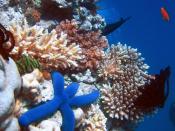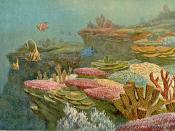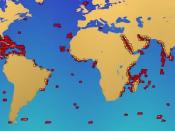WHAT IS CORAL?
"Coral is a common name for members of a large class of marine invertebrates characterized by a protective calcium carbonate or horny skeleton." This is how the Microsoft Encarta Encyclopedia described coral. This calcium carbonate or horny skeleton is also called coral.
Coral may look like an inanimate rock, but it is actually a living animal. Corals belong to a group of animals that include sea anemones and jellyfish. These animals have tentacles with stinging cells and a single opening in the body. This group is known as the Phylum Cnidarians.
How are Coral Reefs formed?
Coral reefs are formed from coral skeletons. Corals secrete a hard skeleton of calcium carbonate as protection for the coral polyps. (A polyp is a can-like body with a single opening leading to the stomach, surrounded by a ring of tentacles.) Each polyp makes a small skeletal cup, called a calyx, which it hides in when inactive or threatened.
As the coral colony grows it must secrete new skeletal material on top of the old. Years upon years later the accumulation of skeletal material forms a coral reef.
What are the conditions necessary for the growth of coral?
Coral reefs can survive in nearly any depth of water. They can be found as deep as 19,700 feet or right at the water's surface, even sticking above water. Corals which build reefs however, must live at depths of less than 150 feet because corals need sunlight to photosynthesize in order to obtain food to eat. Corals grow faster in clean and clear water. This healthy water allows light to reach the algae living in the coral polyp's tissue. Reef building corals need warm temperatures to survive. A good temperature is usually 20 to 28 degrees Celsius. Coral reefs grow more...


